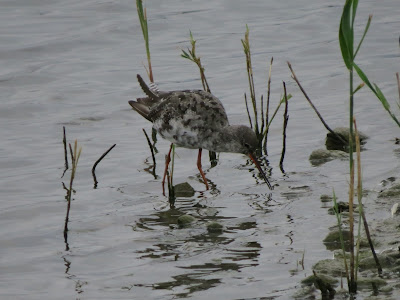Minsmere's Scrape is the perfect habitat for migrant waders, where over the Autumn bare mud is slowly revealed. This bare mud is full of lots of worms and other microscopic beasties which is a great source of food to the birds so attracts a lot of waders to visit.
However as the breeding season winds down things get quiet on the Scrape. With all the GULLS having nested and fledged their chicks they have departed the Scrape, and suddenly where there had been thousands of raucous birds there were now few. Some gulls were still about but nowhere near the number that were here earlier in the Summer.
SPOTTEDD REDSHANK, looking a bit spotty now its moulting out of its summer plumage.
Here is a list of the WADERS I saw on East Scrape:
5 RUFF 3 SPOTTED REDSHANK 5 RINGED PLOVERS 3 COMMON SANDPIPERS
2 DUNLIN
AVOCET
On South scrape numbers were a bit lower. There were :7 DUNLIN 4 LITTLE GULLS 1 ARCTIC TERN
The ARCTIC TERN was amongst the COMMON TERNS. The species look the same except the ARCTIC has short stubby legs, and a tail that stretched out further than its primaries, and had a pale underwing when it flew. This is my first record for Minsmere, you don't get the big colonies like further up north, like the Farnes. To see photos of arctic terns visit my Farne Islands blog.
The LITTLE TERNS on South Scrape were in various stages of breeding and rearing young, ranging from fully fledged young to little baby chicks. Its so good to see them breed successfully at Minsmere as all along the Suffolk coast this species is not doing well, mainly because they nest on beaches and are subject to disturbance.
The COMMON TERNS were also in various stages of breeding, some having fledged chicks whilst others were still nesting. A few SANDWICH TERNS were on East Scrape, but most had moved on.
LAPWING
West Scrape was overgrown with reeds and marestail, and is more vegetated than the rest of the Scrape. This attracts different types of birds, those more secretive in their habits. WADERS were fairly well presented:
1 GREEENSHANK 3 GREEN SANDPIPER 10 SPOTTED RED 1 COMMON SANDPIPER4 RUFF
Resting AVOCETS and GODWITS on East Scrape
A CUCKOO flew over East Scrape. Its so strange that a cuckoo becomes such a major sighting for me. This once common bird is sadly declining, for various complex reasons. Being such a unique bird its problems are less known, than birds with more "normal" breeding habits. As the adult CUCKOOS don't need to raise offspring they leave this country quite early, so this is probably a fledged juvenile.Some BEARDED TITS were seen at North Wall, with many more heard around various reedy areas, but the birds were mainly keeping low down in the reeds.
Record shot of a DARTFORD WARBLER in the dunes
On the beach two pairs of DARTFORD WARBLER were present nesting, one pair behind the public viewpoint and the other in the extensive area of gorse nearer to the sluice. Also present were the usual STONECHAT and LINNETS, all very pretty.
HIGHLAND CATTLE in the Konik Fields
As usual after the Scrape hides I took the path to the reedbed ones. Bittern Hide was fairly quite, two fledged MARSH HARRIER young were present, perched on some bushes, the occasional movement of reedbed WARBLERS, and the odd screeching of WATER RAIL.In the area of woodland on the way to Island Mere Hide there was a family party of JAYS, all screeching away as they squabbled over food. They are such good looking birds its so strange they sound so terrible, such opposites in one bird.
As I got to Island Mere Hide it started raining. What followed could only be described as monsoon weather where over twenty minutes the rain just smashed down. On the mere were various moulting DUCKS, as the birds enter late Summer/early Autumn they shed their breeding season feathers and can't fly, so they find large areas of water to rest on, like Island Mere. There were mainly GADWALL, with smaller numbers of SHOVELLER, TEAL and TUFTED DUCK.
There was still a GREAT CRESTED GREBE nesting on mats of weeds in the middle of the mere, the same one as I saw three weeks ago, which is a long time to be nesting in nature terms. I hope everything is ok.
After the monsoon weather I experienced in Island Mere Hide, there were lots of large puddles on the road, where I encountered this resting TOAD.
So a pretty decent haul for mid July, one of the quieter times of the year. In July Autumn migration hasn't really formed yet and the breeding season is quietly finishing, so things can seem slow. As usual Minsmere is excellent and there is always something good to see, and a visit is worth while. I can never sing this reserve's praises high enough, it really is that good. So go along, visit it, and support it in what it does, because these places need us as much as we need them.








No comments:
Post a Comment